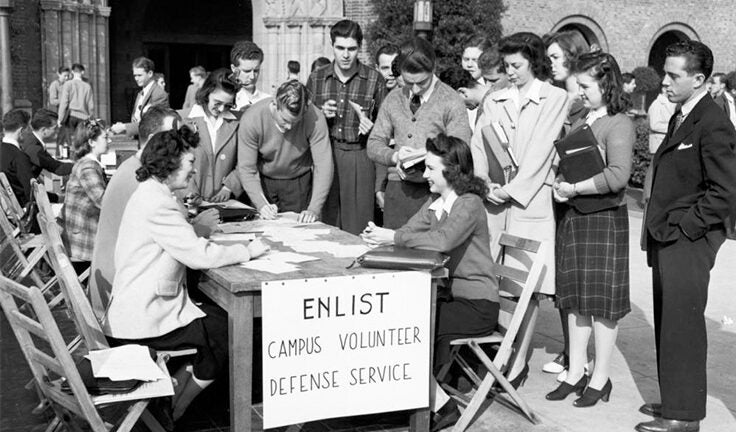
In this picture taken on Dec. 17, 1941, USC students volunteered to support the war effort 10 days after the attack on Pearl Harbor. (Photo/Courtesy of USC University Archives)
World War II Shaped USC History — and the Face of the University
Nearly every corner of campus life transformed as students joined the war effort at home and abroad.
In the days after the Dec. 7, 1941, attack on Pearl Harbor, USC students flooded to Bovard Auditorium to sign up for the Campus Volunteer Defense Service. With a campus in shock, USC administrators addressed students and faculty and staff members to vow to dedicate efforts to the war effort. Students braced for drastic changes. World War II had come, and it would transform nearly every corner of campus life.
Within eight months, USC student enrollment plummeted 15% and 75 faculty members left to join the war. President Roosevelt’s Executive Order 9066 declared that anyone of Japanese descent was a threat to the nation, forcing about 120 USC students to abandon their studies and transfer to internment camps. Academic programs shifted as language, economics, international relations, occupational therapy, photography and aerospace sciences courses expanded. The government chose USC to open a naval preparatory flight cadet school. The Marine Corps Reserves, the Army’s Specialized Training Unit, the Naval V-12 program and the Naval ROTC soon followed. By 1943, more than 1,400 military students were on campus. Two years later, servicemen accounted for more than 75% of the male student body.
Non-military students and faculty members also mobilized to do their part, including researchers who developed technology to protect pilots at high altitude. Students organized a war board to coordinate blood drives, organize air raid and fire hazard training, run health campaigns, raise funds through war bonds and boost morale.
The end of World War II brought joyful celebrations across campus — as well as an influx of returning servicemen. As the campus transitioned to peacetime operations, enrollment soared to 24,000 by 1947, ushering in a modern era at the university.



